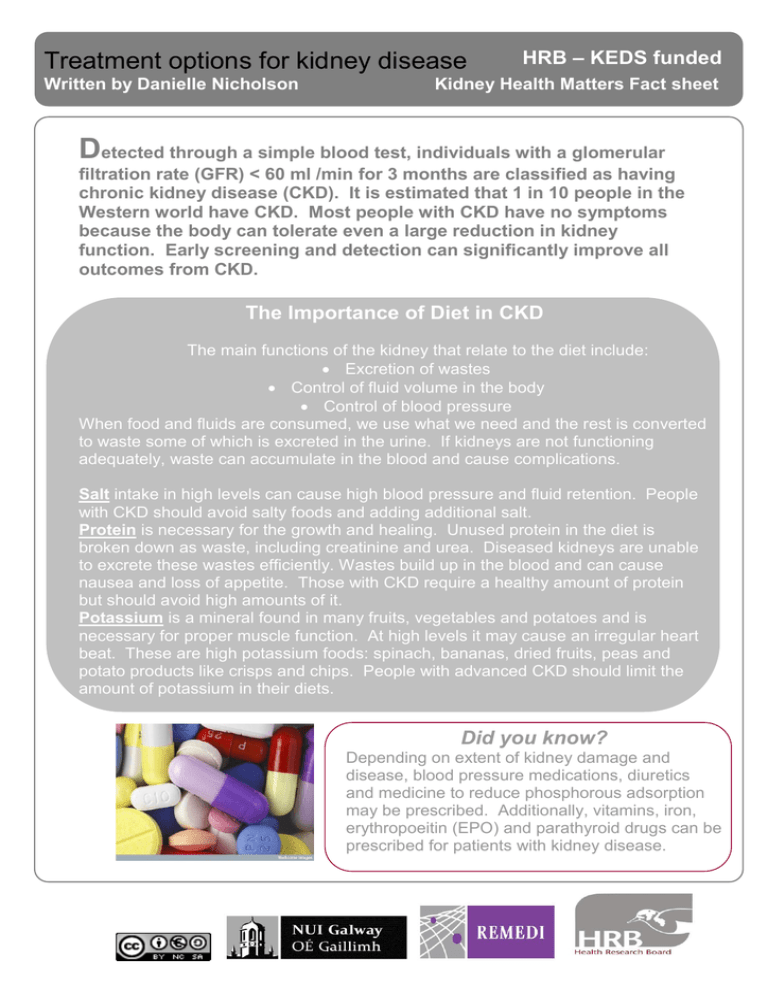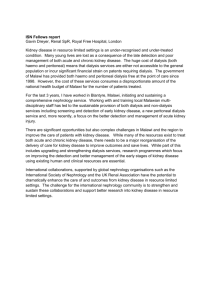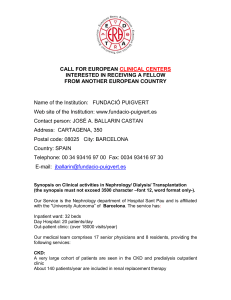D Treatment options for kidney disease – KEDS funded HRB
advertisement

Treatment options for kidney disease Written by Danielle Nicholson HRB – KEDS funded Kidney Health Matters Fact sheet Detected through a simple blood test, individuals with a glomerular filtration rate (GFR) < 60 ml /min for 3 months are classified as having chronic kidney disease (CKD). It is estimated that 1 in 10 people in the Western world have CKD. Most people with CKD have no symptoms because the body can tolerate even a large reduction in kidney function. Early screening and detection can significantly improve all outcomes from CKD. The Importance of Diet in CKD The main functions of the kidney that relate to the diet include: Excretion of wastes Control of fluid volume in the body Control of blood pressure When food and fluids are consumed, we use what we need and the rest is converted to waste some of which is excreted in the urine. If kidneys are not functioning adequately, waste can accumulate in the blood and cause complications. Salt intake in high levels can cause high blood pressure and fluid retention. People with CKD should avoid salty foods and adding additional salt. Protein is necessary for the growth and healing. Unused protein in the diet is broken down as waste, including creatinine and urea. Diseased kidneys are unable to excrete these wastes efficiently. Wastes build up in the blood and can cause nausea and loss of appetite. Those with CKD require a healthy amount of protein but should avoid high amounts of it. Potassium is a mineral found in many fruits, vegetables and potatoes and is necessary for proper muscle function. At high levels it may cause an irregular heart beat. These are high potassium foods: spinach, bananas, dried fruits, peas and potato products like crisps and chips. People with advanced CKD should limit the amount of potassium in their diets. Did you know? Depending on extent of kidney damage and disease, blood pressure medications, diuretics and medicine to reduce phosphorous adsorption may be prescribed. Additionally, vitamins, iron, erythropoeitin (EPO) and parathyroid drugs can be prescribed for patients with kidney disease. Treatment options for kidney disease Written by Danielle Nicholson HRB – KEDS funded Kidney Health Matters Fact sheet Dialysis is a treatment for severe kidney failure (stage 5 chronic kidney disease and end-stage renal disease). Dialysis replaces a portion of the function of the failing kidneys by filtering and removing excess fluid and waste from the blood. The dialyser extracts the toxins and water until a suitable concentration is achieved, then the cleansed blood is returned to the body. Which type of dialysis is best? Once dialysis becomes necessary, patients and their physicians should consider the advantages and disadvantages of the types of dialysis: haemodialysis (in-centre or home) or peritoneal dialysis. The choice can be influenced by a number of issues such as availability, convenience, underlying medical problems, home situation and independence. Patients treated with home haemodialysis can often lead more independent lives and may have improved survival outcomes compared to those treated in a dialysis centre. This is due, in part, to home hemodialysis patients having more frequent or longer dialysis treatments than those treated in a dialysis centre. Home dialysis is generally done 3- 7 times per week and takes between 3 and 10 hours per session. Dialysis centre treatment may be done in a hospital, a clinic associated with a hospital, or a free-standing clinic. Centres are staffed with highly trained nurses and technicians. Generally, in-centre hemodialysis takes between 3 and 5 hours and is done three times per week. Peritoneal dialysis (PD) is performed at home and removes excess fluid and waste products from the blood. Before PD begins, a catheter (thin tube) is inserted in the abdomen to carry fluid into and out of the abdominal cavity. The flexible catheter has cuffs that skin tissue grows into to hold it in place. The end of the catheter inside the abdomen has multiple holes to allow fluid to flow in and out. Dialysis fluid (called dialysate) is infused into the abdominal cavity through a catheter. The fluid is held within the abdomen for a prescribed period of time; this is called a dwell. The lining of the abdomen acts as a membrane to allow excess fluids and waste products to pass from the bloodstream into the dialysate. When the dwell is completed, the "used" dialysate is drained out of the abdomen into a container. This used fluid contains the excess fluid and waste from the blood, which is usually eliminated in the urine. This process is repeated, as necessary usually 4- 5 times each day with each exchange taking 30 – 40 minutes. Dialysis ≠ The kidney Haemodialysis Treatment around the world: -For most patients: 3 days per week -Average duration: 3- 5 hours - A kidney works 24 hours/ day - 7 days per week - 365 days per year In many cases, the best treatment option is transplantation.



